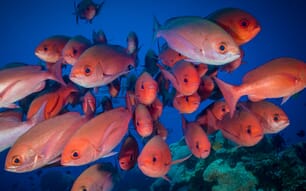Freshwater ecosystems are increasingly under threat from both climate change and expanding human populations. Climate change has led to lower levels of rainfall in many parts of the world, reducing freshwater stream flows, while growing populations will consume increasing amounts of freshwater and generate more polluted wastewater. This has led to many rivers and streams becoming dominated by processed sewage effluent.
Sewage effluent contains a complex mixture of chemicals, including pharmaceuticals, which are not completely removed during treatment. Among these are steroidal oestrogens, such as 17α-ethinylestradiol (EE2), from human birth control pills, that have been shown to negatively affect fish reproduction. However, oestrogens may also influence populations of fish through mechanisms other than reproduction, such as reducing survival, and have cumulative effects only seen over multiple generations.
Schwindt, A. R., Winkelman, D. L., Keteles, K. et al examined the effects of EE2 exposure on populations of fathead minnow (Pimephales promelas) fish, over multiple generations. They used concentrations of EE2 in the range commonly found in the environment as a result of wastewater effluents, from approximately three to approximately 11 nanograms per litre (ng L-1 ). They also included near-zero control treatments, and complemented experiments in outdoor water tanks representing near-natural conditions with experiments in laboratory aquaria.
EE2 was found to increase the chance of death in male fish by a factor of 1.7 for each 1 ng L-1 of EE2 added. No males survived longer than 126 days when exposed to 11 ng L-1.
Females were less affected, with around 50 per cent surviving over the same time scale. In the wild, fathead minnows have a lifespan of between one and three years.
Additionally, exposing the first generation during their reproductive season reduced the number of eggs, embryos and juvenile fish produced at all EE2 concentrations tested.
Exposure of the second generation to EE2 early in life resulted in almost no eggs or larvae being produced. Even at the lowest concentration, survival of the third generation was also reduced even though the parents were transferred to unpolluted water for five months before reproduction.
These results show that exposure to EE2 at real-world levels can disrupt fathead minnow population dynamics by affecting reproduction over multiple generations, suggesting that fish populations may not be able to recover following oestrogen exposure.
While this research is based on North American data and species, the findings are relevant to all fish with high reproductive rates and relatively short lifespans in environments contaminated with relevant oestrogen levels, say the researchers.
Overall, the authors of the study conclude that this work suggests that there may be an ecological benefit to upgrading wastewater treatment plants to remove oestrogen-like pollutants. They also suggest a number of possible actions to reduce harm from oestrogens in freshwater ecosystems. These include conserving breeding and rearing habitats in unpolluted areas and maintaining connections between and within rivers and streams.
'An environmental oestrogen disrupts fish population dynamics through direct and transgenerational effects on survival and fecundity' was published in the Journal of Applied Ecology.




